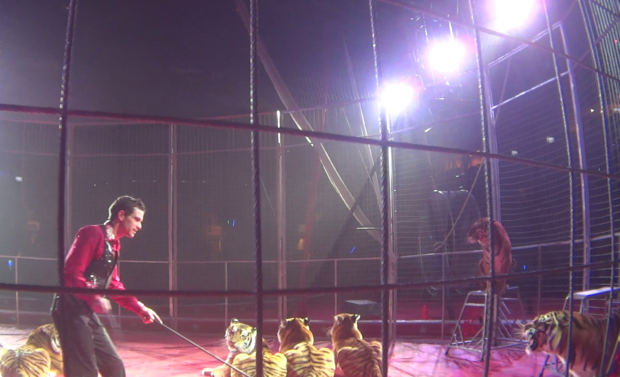
It’s painful to watch a grown man whipping a majestic tiger and watching the world’s most powerful predator flinch and cower in fear. Photo by The HSUS
A new HSUS undercover investigation reveals the mistreatment of eight tigers featured in Ryan Easley’s ShowMe Tigers act – a traveling circus gig that is contracted out to branded circuses. It’s painful to watch a grown man whipping a majestic tiger as the world’s most powerful predator flinches and cowers in fear. It’s a coercive training technique used to force tigers to perform demeaning and often difficult tricks.
This is the backstory that animal-based circuses don’t want you to see. It’s the reality for tigers and other wild animals trapped in these operations. Our investigator spent three weeks working for Easley, including nine days on the road with the act that has toured with Carden Circus and performed for several Shrine circuses.
As you can see in our undercover video, the tigers endure a great deal of trauma. Even a layperson can recognize the signs of stress, including cringing and bolting from Easley (who uses the stage name Ryan Holder) when he raises his whip and stick. The tigers squint and flatten their ears back, because they’ve felt the lash before. Their shoulders are hunched, defeated. It is simply unethical to force one of the world’s most powerful and extraordinary predators to hop around on her hind legs as a Michael Jackson tune blares over the loudspeakers.
At the ShowMe Tigers act, the trainer holds back on obvious abuses during the live performance. It’s out of the circus ring that the more intense punishment occurs. Our investigator videotaped a practice session that showed, among other things, a traumatized tiger being whipped at 31 times in less than two minutes because she refused to get off a pedestal. Whip marks would suddenly appear on a tiger’s fur during both the practice session and live performances, confirming that the whip was making physical contact and not just being used as a threat.
What’s particularly stark for me is the difference between how circuses treat tigers and how legitimate sanctuaries treat captive cats. At The Fund for Animals’ Cleveland Amory Black Beauty Ranch, and other sanctuaries accredited by the Global Federation of Animal Sanctuaries, tigers rescued from captive situations love to swim and rest on elevated platforms and lie on cool grass. They chase and tear apart enrichment items provided by dedicated caretakers. Staff specialists go to great lengths to ensure that the sanctuary’s tigers stay physically active and mentally stimulated. In contrast, Easley’s tigers go through the same mind-numbing cycle each day: eating, sleeping, pacing, urinating, defecating in the approximately 13 square feet of floor space for each tiger kept in transport cages, and suffering through eight-minute performances up to three times each day. Once the act hits the road, the tigers live exclusively in tiny, barren transport cages. Our investigator observed other forms of neglect, too, such as lack of protection from bitterly cold weather, a nutritionally deficient diet, and failure to provide veterinary care to a tiger with a raw, open wound near her eye.
We’re seeing states as well as small and large communities taking steps to protect wild animals from abuse and suffering at the circus. In some cases, legislators are banning cruel training tools while others are passing outright bans on the use of various species in traveling shows. We are leading efforts in states and cities across the country to end the era of captive wild animal acts. We’re ready to work with anyone interested in pursuing a circus ordinance in their community. Please contact wildlife@humanesociety.org to request a circus toolkit.
The post HSUS investigation pulls the curtain back on tiger abuse by traveling circus trainer appeared first on A Humane Nation.
Enviroshop is maintained by dedicated NetSys Interactive Inc. owners & employees who generously contribute their time to maintenance & editing, web design, custom programming, & website hosting for Enviroshop.
